USF research included in TV special on Gulf spill, Tampa Tribune, September 27, 2010:
Excerpts
Green News, Earth, Air, Fire, Water, Spirit, Environment, Healing, Peace, Political Resistance in Florida. News gathering space for Crimes Against Humanity & Ecocide in the Gulf of Toxico & after affects on life here. Now covering FRACKING, MINING, LNG PIPELINES, WATER QUALITY & so many more environmental issues. Hoodooing in the Green Swamp & other Wild Places throughout our State.
BP pays travel writers to ‘make it right’, Los Angeles Times September 28, 2010:
Pensacola
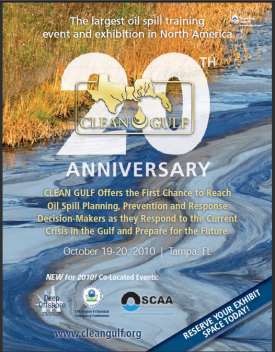
Big Oil is throwing a party for getting away with raping the Gulf but residents have planned a protest to raise awareness of the danger of Corexit and to push lawmakers to ban it. If you can attend then RSVP below. If not pass it on to everyone you know.
Just in via Facebook:
Anita Stewart http://www.facebook.com/event.php?eid=149654818404994&ref=ts
These evil people are actually having a conference for the OIL SPILL CLEANUP industry in Tampa and Orlando. We are planning a protest and a press conference OUTSIDE. If you want to be a part of this, please RSVP on the event page and make it a point to BE THERE…and be sure to pass this on to your peeps in Tampa and Orlando…
And they are even calling this event: http://www.cleangulf.org/
Anti Dispersant Demonstration
Location:The Tampa Convention Center
Time:12:00PM Tuesday, October 19th and 12:00PM Tuesday, October 20th
And from the Event Demonstration Page:
Time Location The Tampa Convention Center 333 S Franklin StTampa, FLCreated By More Info Oct 20th as well same time .NALCO will be af vendor at this event. Our aim is two fold raise public awareness about the dangers of dispersants and eventually get the EPA to ban the use of Corexit. Several Gulf states are sponsoring this convention which they are calling “Clean Gulf”.
From CleanGulf:
250+ Exhibitors. More than 65 Speakers. Over 20 training sessions, panel discussions and workshops. Plan now to attend North America’s largest oil spill event for operators, responders and regulators.
CLEAN GULF is an essential destination for reaching key decision-makers and leaders who represent hundreds of millions of dollars of buying power. Showcase, demo and sell your products and services to buyers you will not see at other events.
Looking to build your brand and increase booth traffic? Stand out from the competition with our robust sponsorship packages that will enable you to prominently communicate your message to important, fast-growing marketplaces.
Check out our special expo-only packages, which include access to our one-of-a-kind solutions exhibition showcasing the latest tools and technologies… plus the keynote and general sessions and top-caliber networking receptions.
If you can attend the demonstration then RSVP here.
If not pass this on to everyone you know.

Corporations are not people and money does not equal free speech.
THE CORPORATIONS RULE US...not our elected leaders. Does not matter what side of the aisle our leaders are from, they are ALL crooked and taking the... $$$ and making us drink the Kool Aid...NO MORE! I am SOOO done, stick a fork in me!
http://www.movetoamend.org Do you think our leaders write the legislation that makes our laws? Think again! THE CORPORATIONS WRITE OUR LEGISLATION! Take the money out of politics, vote the corporate bastards out and elect CITIZEN LEADERS at all levels of government, the ones that are not on the take. If they have no money to finance their campaigns and are still running a campaign, then they are probably sincere, why else would they want to serve?...Vote for THOSE GUYS...See http://www.opensecrets.org/ to see how much YOUR reps are taking...and from whom. And then EXPOSE them and don't vote for them! Encourage others to do the same. Then do not buy anything, just STOP...do not spend anything on retail, seek out recycled and repurposed and second hand for what you need. Get your food from Green markets, support your local businesses instead of BIG BOX stores...THAT is our REVOLUTION folks...and it will not include bloodshed. Just REFUSE to play their game...Time for THIRD PARTIES and their candidates...Anita Stewart
Sept 28, 2010

Every generation or so, a major secular shift takes place that shakes up the existing paradigm. It happens in industry, finance, literature, sports, manufacturing, technology, entertainment, travel, communication, etc.
I would like to discuss the paradigm shift that is occurring in politics.
For a long time, American politics has been defined by a Left/Right dynamic. It was Liberals versus Conservatives on a variety of issues. Pro-Life versus Pro-Choice, Tax Cuts vs. More Spending, Pro-War vs Peaceniks, Environmental Protections vs. Economic Growth, Pro-Union vs. Union-Free, Gay Marriage vs. Family Values, School Choice vs. Public Schools, Regulation vs. Free Markets.
The new dynamic, however, has moved past the old Left Right paradigm. We now live in an era defined by increasing Corporate influence and authority over the individual. These two “interest groups” – I can barely suppress snorting derisively over that phrase – have been on a headlong collision course for decades, which came to a head with the financial collapse and bailouts. Where there is massive concentrations of wealth and influence, there will be abuse of power. The Individual has been supplanted in the political process nearly entirely by corporate money, legislative influence, campaign contributions, even free speech rights.
READ THE REST OF THE ARTICLE HERE:
USF research included in TV special on Gulf spill, Tampa Tribune, September 27, 2010:
Excerpts
The [University of South Florida researchers] discovered plumes of dispersed oil at the bottom of an undersea canyon about 40 miles off the Florida Panhandle.
It was found to be toxic to microscopic sea organisms, causing mutations to their DNA. …
“I call these canaries in the coal mine as they are the first to feel the effects,” [University of South Florida researcher John Paul who is included in a documentary debuting Tuesday night in the National Geographic Channel] says. …
“The problem with mutant DNA is that it can be passed on and we don’t how this will affect fish or other marine life,” he says, adding that the effects could last for decades.
September 26th, 2010
Toxicologist Dr. Riki Ott Interview, Ring of Fire Radio (Mike Papanatonio, Esq.), September 25, 2010:
Transcript Summary
Papantonio: Corexit it’s being dumped into the gulf even as we speak…
Ott: We have ample evidence now that these toxic chemicals and solvents are being sprayed directly into inland waters. … This puts dispersants into people’s backyards.

BP’s Corexit 9527A, used to disperse the oil, contains between 30-60% 2-butoxyethanol
Hazardous Substance Fact Sheet for 2-BUTOXY ETHANOL, New Jersey Dept. of Health and Human Services, August 2008 (Revised):
Excerpts
2-Butoxy Ethanol should be handled as a CARCINOGEN–WITH EXTREME CAUTION. …
The following chronic (long-term) health effects can occur at some time after exposure to 2-Butoxy Ethanol and can last for months or years:
Cancer Hazard: 2-Butoxy Ethanol may be a CARCINOGEN in humans since it has been shown to cause liver cancer in animals. Many scientists believe there is no safe level of exposure to a carcinogen.
Reproductive Hazard: 2-Butoxy Ethanol may damage the developing fetus. There is limited evidence that 2-Butoxy Ethanol may damage the male reproductive system (including decreasing the sperm count) in animals and may affect female fertility in animals.
2-Butoxy Ethanol may damage the liver and kidneys.
SEE MORE AT THE LINK:
http://www.floridaoilspilllaw.com/state-2-butoxyethanol-corexit-9527a
IMPORTANT URGENT PLEASE HELP US GET THIS OUT FAST sorry we just found out!
VIA: Rob Coulon
The National Academy of Sciences Institute of Medicine is meeting today and tomorrow to conduct a review of the “Federal Response to the Health Effects Associated with the Gulf of Mexico Oil Spill.” FINALLLY - great news, right? The conference includes many of the brightest doctors and researchers to discuss the health implications from human exposure to 4.9 million barrels of oil and 1.8 million gallons of Corexit. This is long over due…. Yes? Wait, lets look at this a little bit closer, shall we?
It screams to me WHY?
If they are asking for the affected residents of Louisiana, Mississippi, Alabama & Florida to attend and give input on their health issues, why not widely promote it heavy in those areas? Better yet, why not hold the conference in an area where people could actually attend? A midway point perhaps? The very people who need to attend do not have the financial means and good health to travel to Tampa to be counted. Plaquemines Parish is ground zero of this oil spill. The parish officials had no idea about this conference.
None of this made any sense to me, so I decided to dig deeper.
Here are a few interesting facts:
At the request of the U.S. Department of Health and Human Services, the IOM convened a public workshop June 22-23 2010 to begin planning for the surveillance of the Gulf oil spill's effects on human health. Speakers explored the potential adverse health effects for at-risk populations living in the Gulf region in general or assisting with clean-up activities. Participants also discussed current monitoring activities, the types of research methods and data sources currently available, and options to consider when developing short- and long-term surveillance plans. Additionally, participants considered effective ways to communicate potential health risks to the public and to engage them in research on the spill's effects.
On August 10,2010 - They released the document Summary “Assessing the Effects of the Gulf of Mexico Oil Spill on Human Health” which talks openly and very honestly about the use of dispersants and the oil spill in relation to human health - both long tem and short tem effects were taken into account. This document can be viewed at the link below. It is one of the first that seemed to mirror exactly what is going on with the health of people here in the Gulf. It explains in great detail the nature of illnesses and human health dangers associated with the spill and I was excited to read it being so well done by a reliable and well known source. It seemed that we might finally get somewhere on this topic.
http://books.nap.edu/openbook.php?record_id=12949&page=55 Then, as luck would have it - They received a $10 million dollar grant to fund the project! What a huge break for the people of the Gulf region! Right?
Oh… wait…
On September 7, 2010, BP announced it would provide $10 million to the National Institutes of Health (NIH) for research into the potential health problems resulting from the Gulf of Mexico oil spill. BP stated that the funds are intended to expedite work on the research priorities identified at the IOM’s June 22-23 workshop, "Assessing the Human Health Effects of the Gulf of Mexico Oil Spill."
Ouch.
And here we find ourselves right back at the beginning of this note… asking WHY? Why would they hold a conference asking for cooperation of the affected people of the Gulf region; asking them to attend this meeting in Tampa without any advance notice and without making the state and Parish/Counties officials aware? Without even once contacting the actual people from whom they need input for the study - nor making it public by any means of promotion they will conclude our health issue impact! Perhaps it was an oversite? Perhaps they will not state in the study that no one showed up to confirm or report any health issues so must not be any. Perhaps, if we send them a note via email they will give us a way to offer feedback now - before the meeting ends Friday September 24 2010 without any input from those actually affected. I urge any and everyone with health issues to email us at CHSL with the following information so that we can send them the collected information - even if it means that we stay up all night compiling it and making sure it happens!
You can confirm the above with them - the contact info is:
The National Academy of Sciences Institute of Medicine
Office of Reports and Communication
Phone: 202-334-2352
Fax: 202-334-1412
DO NOT let this happen. Be heard. Speak up! You have less than 12 hours to do so.
Email the following info to us.
Send info to Laheritagesociety@gmail.com
-- Visit us online at www.CHSLouisiana.org
TESTING THE WATER - CITIZEN'S COALITION UPDATE
This grassroots movement of concerned citizens is dedicated to ascertaining the true magnitude of health risks associated with exposure to oil and chemical dispersants in the Gulf waters through independent laboratory testing. Our citizen's coalition supports the advocation of the Precautionary Principle when it comes to Environmental Protection & Safety.
Our latest test results came back positive for 179 parts per million of oil on Sarasota beach.
Interpretation
This finding is highly significant, as it appears the tide brought in weathered oil from beneath the surface of the Gulf, and that this will probably continue as we experience more storms and wave action moving forward into hurricane season. Keep in mind that the EPA's latest toxicological analysis of the crude oil from the Macondo prospect well showed it had an extraordinarily high toxicity, namely, 2.7 ppm was lethal to 50% of the test fish (Menidia) within 96 hours of exposure. Do we want our children playing in this sand? Or swimming in the water?
The next step is to fingerprint the oil with an in-depth hydrocarbon test which will tell us if this is the same oil as from the Deepwater Horizon well.
The time for action is now. We need to raise funds, #1: to get further testing on are already positive sample. #2 to embark on regular sand and water sampling throughout the coastal area. You can donate here http://www.testingthewater.org/donate

Hi Alexander
Here is a lovely photograph of a BP contractor off Devil’s Bay LA, hes a bit camera shy due to the effect that hes been caught in a BP Black OPS in spreading his load of corexit. Enjoy the photo.
See more on this at the link:
Sarasota Water/Sand
Tests, www.testingthewater.org, September 22, 2010:
Summary of Testing
Sayer Ji of www.testingthewater.org: The hydrocarbons are “concentrating in the sand… to toxic levels.”
It should be noted that the Siesta Key/Sarasota area is also the first place on Florida’s west coast that would be impacted by the BP oil disaster according to several models put out by the federal government.
SEE MORE HERE:Ott, concerned about an aftermath as devastating as the one after the Valdez spill or worse, rushed down to the Gulf to investigate and is there still. She has been tracking a significant outbreak of medical problems among people who have been in contact with the Gulf water. Primarily she has seen persistent skin rashes that do not respond well to any kind of treatment. While they have commonly been misdiagnosed as bacterial in nature, (e.g. staph infections) or parasitic (e.g.scabies), there is growing evidence that the cause of these rashes are chemical in nature.
Residents and visitors have reported that they have “developed a rash or peeling palms from swimming, wading, handling oiled material or dead animals without gloves and shucking crabs from recently re-opened Gulf fisheries.” Some have even reported symptoms after swimming in their outdoor pools after a rain.
Criticizing the heavy-handed use of dispersants before Congress, former NOAA Chief Scientist Silvia Earle said, “The instructions for humans using Corexit, the dispersant approved by the EPA to make the ocean look better warn that it is an eye and skin irritant, is harmful by inhalation, in contact with skin and if swallowed, and may cause injury to red blood cells, kidney or the liver. People are warned not to take Corexit internally, but the fish, turtles, copepods and jellies have no choice. They are awash in a lethal brew of oil and butoxyethanol.”
William Rea, MD, who founded the Environmental Health Center-Dallas, and who treated a number of sick Exxon Valdez cleanup workers, said, “When you have sick people and sick animals, and they are sick because of the same chemical, that’s the strongest evidence possible that that chemical is a problem.”
Ott claims that the government, BP and local business people all want to downplay the problem and pretend that the spill and all of its impacts are over.
READ MORE AT THE LINK:
NEW YORK - Now that BP's Deepwater Horizon oil well has been sealed, the long, hard work of assessing the damage begins even as the oil is dispersing throughout the Gulf.
A research team from Columbia University in New York returned this past weekend (Sept. 17 to 19) from a tour of duty in the Gulf of Mexico with new data to attempt to measure the location and magnitude of subsurface oil plumes, and their effects on the marine ecosystem, which have recently been the focus of much debate.
They found oil on the seafloor, evidence that it may be in the food chain, and signs that it may be hidden in large marine mammals. In spots, the "oily snow" — degraded oil and other organic material that clings to it — was up to 6 inches (15 centimeters) deep on the seafloor, said Columbia oceanographer Ajit Subramaniam.
"The idea that the oil is degraded and therefore doesn't matter is something we have to think about differently," Subramaniam said at a talk here today. "This is one of the first findings that showed degraded oil material collected on the seafloor."
READ MORE AT THE LINK:
http://www.livescience.com/environment/gulf-oil-spill-underwater-plumes-100921.html
Ocean Springs, AL. A grandmother made me rethink all the bio-remediation hype. The "naturally-occurring oil-eating bacteria" have been newsworthy of late as they are supposedly going to come to the rescue of President Obama and BP and make good on their very premature statement that "the oil is gone."
We were talking about subsurface oil in the Gulf when she said matter-of-factly, "The bacteria are running amok with the dispersants." What? "Those oil-eating bacteria - I think they're running amok and causing skin rashes." My mind reeled. Could we all have missed something so simple?
The idea was crazy but, in the context of the Gulf situation - an outbreak of mysterious persistent rashes from southern Louisiana across to just north of Tampa, Florida, coincident with BP's oil and chemical release, it seemed suddenly worthy of investigating.
I first heard about the rash from Sheri Allen in Mobile, Alabama. Allen wrote of red welts and blisters on her legs after "splashing and wading on the shoreline" of Mobile Bay with her two dogs on May 8. She reported that "hundreds of dead fish" washed up on the same beach over the following two days. This was much too early for the summer sun to have warmed the water to the point of oxygen depletion, but not too early for dispersants and dispersed oil to be mixed into the Gulf's water mass. By early July, Allen's rash had healed, leaving black bruises and scarring.
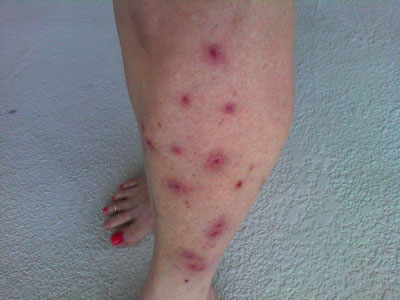
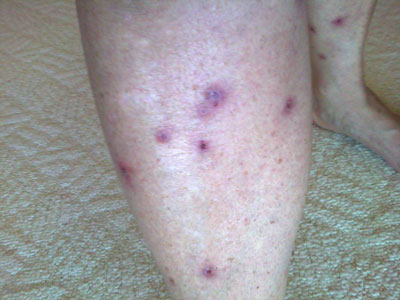
Other people - both residents and visitors to the Gulf coast - wrote of similar rashes or other skin problems like peeling palms. The rashes have been diagnosed as scabies and staph infections, including MRSA, the potentially lethal Methicillin-resistant Staphylococcus aureus bacteria. Most cases lingered for months, as the rash did not respond well to antibiotics, steroid creams, or steroid shots.
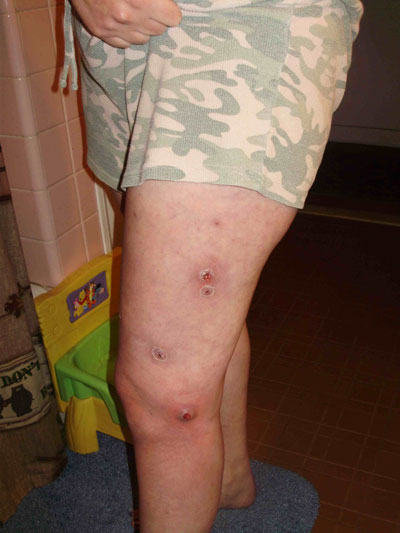
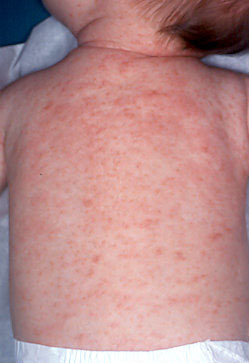
That should have been a clue that maybe the primary cause was not biological, but chemical. A secondary biological infection might clear up with antibiotic treatment, but then keep reoccurring because the primary chemical illness had not been treated.
Retired Registered Nurse Allison Schmidt agrees. Referring to Allen's case, she said, "I can say without hesitation that these skin rashes have nothing to do with scabies. Scabies is a parasite, which causes a skin infection and is extremely contagious. It spreads from person to person by direct skin contact or by wearing an article of clothing worn by an infected person." Schmidt said, "If this were scabies you would see entire families infected and NOT just a single family member."
Another clue to the real cause of the mystery rash is its prevalence across the entire oil-impacted Gulf. Something in the water or air, or both, could explain this. While public officials and BP claim that dispersant use was halted in May for Corexit 9527A and on July 19 for Corexit 9500A, evidence collected by Gulf residents has shown that dispersants are being used in nearshore and inland waters, close to highly populated areas across the Gulf. Further, oil and the Corexit marker have been found in air and inland water.

I have heard from Gulf residents and visitors who developed a rash or peeling palms from contact with Gulf water, including such activities as swimming or wading, getting splashed, handling oiled material or dead animals without gloves, and shucking crabs from the recently opened Gulf fisheries. I have also heard from people who developed the same symptoms after contact with Gulf air by wiping an oily film off their airplane's leading edges after flying over the Gulf (absorbent pad tested positive for oil) or swimming in outdoor pools, or splashing in puddles, after it rained.
Outraged by the unprecedented release of oil and toxic chemicals in the Gulf, Nurse Schmidt and Mike McDowell developed a project to test Gulf rainwater for harmful chemicals. Schmidt said, "We are convinced the chemicals used in the Gulf to help disperse oil have evaporated and will eventually come down mixed with the rain."
by Maya Rodriguez / Eyewitness News
Posted on September 16, 2010 at 6:27 PM
Updated today at 6:38 PM
NEW ORLEANS-- Some independent scientists, who have been looking into oil spill contamination in the Gulf of Mexico, said they have received some unsettling phone calls from the federal government.
The calls came from attorneys, on behalf of the National Oil Spill Commission. The scientists said their questions seemed designed to cast doubts on their findings.
As the oil spill unfolded, scientists from research institutions around the country descended on the Gulf to witness what ended up becoming an unprecedented environmental event. Two of those scientists included Dr. William Sawyer, a Florida-based toxicologist, and Marco Kaltofen, a scientist and head of Boston Chemical Data in Massachusetts.
"Right now, the Gulf is basically a big experimental laboratory," Sawyer said.
Both were hired by a New Orleans-based law firm to collect and analyze samples of water, sand and sea life that had been affected by the oil spill.
"What has been most important to us is to make sure that we have independent data, that is gathered from along the coast, where our clients reside," said attorney Stuart Smith, of the Smith Stag Law Firm, which hired Sawyer and Kaltofen.
The scientists looked at samples from off the coast of several Gulf states, including Louisiana. They said, so far, their findings are troubling.
MORE AT THE LINK AND A VIDEO:It has happened three times in two months. First with Time magazine, then twice with the New York Times.
A story in a national publication says the Deepwater Horizon disaster might not be quite as bad as everyone feared. Government and oil company employees nod their heads, eager to send the message that their cleanup efforts are succeeding.
Then comes the backlash, along with further evidence that the oil is still wreaking havoc.
The most recent example offers the most dramatic turnaround. On Monday, the New York Times published a story on its website headlined "Gulf May Avoid Direst Predictions After Oil Spill." Preliminary reports from scientists "suggest that the damage already done by the spill may also be significantly less than was feared," the story reported.
Then, on Tuesday, the Associated Press reported that scientists had found a layer of oil 2 inches thick on the ocean bottom. Under the oil, they found dead shrimp.
"It's kind of like having a blizzard where the snow comes in and covers everything," University of Georgia researcher Samantha Joye told the AP from aboard a research vessel.
On Monday, the New Orleans Times-Picayune published startling photos from a Louisiana bayou that had been hit by the oil. An enormous fish kill had just occurred. Redfish, crabs and shrimp covered the bayou from bank to bank, looking at first glance like a gravel road.
READ MORE AT THE LINK:For anyone thinking that the Gulf of Mexico oil spill is all over, our next report just might make you think again. Down on the Louisiana coast, one very determined woman - a granny who also happens to be a leading environmental scientist - has been collecting a hefty list of locals whose health has been damaged by the spill. Needless to say, BP is not impressed but that doesn't bother her one little bit! Here she is with Sophie McNeill.
REPORTER: Sophie McNeill
It seems life is returning to normal on the Gulf Coast. But appearances can be deceptive.
WILMA SUBRA, ENVIRONMENTAL SCIENTIST: It looks like it has a little bit of oil in the sand that it’s washing in. Until all the slick and all the dispersed oil is out of the Gulf I wouldn’t consider swimming here.
Environmental scientist Wilma Subra is a Louisiana local with a long track record of fighting the big polluters. Apart from the oil, she’s concerned about what else might be in the water. She believes BP’s attempts to break up the oil may have created long-term problems.
WILMA SUBRA: The dispersant is a very toxic substance that causes a lot of health impacts - short term and long term. Portions of them are known cancer-causing agents, the other portion causes the headache, the nausea, the respiratory problems and when it is mixed with the oil, it is much more toxic than either the oil or the dispersant. And you can inhale it, you can ingest it, you can have skin contact out here. So, it is an issue that is really important for people’s health. They need to be protected from any exposure.MORE AT THE LINK:
Coastal Heritage Society of Louisiana Radio with Kindra Arnesen, September 14, 2010:
Transcript Summary
We’re having more oil coming in today…
There’s fishkills everywhere… all over Plaquemines…
My understanding is there’s a lot of fresh, new oil coming in…
It’s not dispersed oil…
We’re back to the red, lumpy… oil…
Oh my God…
And where is that coming from? No one can answer that question for me.
Listen to the CHSL radio program here.
MORE AT THE LINK:BP and the government decided that millions of gallons of dispersants should be used on the Gulf oil spill to sink and hide the oil.
They succeeded in sinking it. As ABC, CBS and NPR note, huge quantities of oil are blanketing the ocean floor, killing virtually all of the sealife which lives there.
And giant new underwater plumes have been found in the water column itself.
But the oil is not staying hidden.
Oil is suddenly emerging in many parts of the Gulf.
Oil “patties”, 1 to 3 inches across, have been discovered floating along the seawall in Alabama.
16 miles of beaches in Louisiana have been hit. And scientists say that the oil will arise and wash ashore in pulses, and will hit sensitive areas like coastal marshes.
As CNN reports, we might be facing a worst-case scenario in Florida:
LARRY MCKINNEY, HARTE RESEARCH INST. FOR GULF OF MEXICO STUDIES: … [T]hey do tend to support some of our greatest concerns about the fate of these underwater plumes that were discovered back in June, and that is that they could be picked up and this conveyor belt that is upwelling in Desoto Canyon and bringing this oil from the deep waters up to the shallow, and that seems to be what the Florida State folks are saying. …
JOHN ROBERTS, CNN ANCHOR:… [T]he USF study said, quote, “These findings, although preliminary, suggest that subsurface oil may be emerging on to the west Florida shelf through the Desoto Canyon.” So this is not just restricted to the extremely deep water. There’s enough welling as you mentioned before. How widespread could this become?
MCKINNEY: Well, it depends on how big those plumes are and how long they persist, but that conveyer belt moves water rather quickly. And so the fact that the Florida state folks are finding oil up on that shelf at the distance that they’re finding it is disturbing from that regard. That means that that oil plume could be moving up on the shelf and that’s sort of a worst case scenario. We would not like to see that at all.
SEE MORE AT THE LINK:
http://blog.alexanderhiggins.com/2010/09/15/gulf-oil-refuses-to-stay-hidden-underwater-5135/